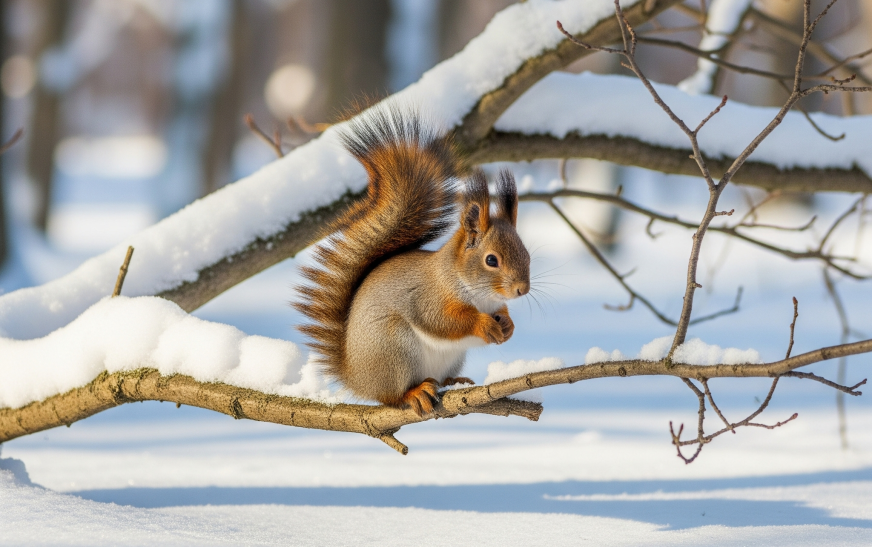You understand their science, you know their legends, and you appreciate just how rare they are. Now, only one question remains: where in the world can you actually see an albino squirrel?
While a sighting can theoretically happen in any backyard or park where squirrels thrive, the odds are astronomically low. It’s a true game of chance. However, if you want to trade chance for a better probability, there are a few unique places in the United States—specific towns and university campuses—that have become famous “hotspots” for these snow-white creatures. These are the locations where, due to a concentrated gene pool and local protection, your chances of a magical encounter are significantly higher.
This guide will take you on a tour of the most renowned locations for spotting albino squirrels, turning a hopeful wish into a potential travel plan for any dedicated nature lover.
The Undisputed Capital: Olney, Illinois
There is no better place to start this journey than in the small town of Olney, Illinois, which proudly calls itself the “Albino Squirrel Capital of the World.” This isn’t just a catchy slogan; it’s a core part of the town’s identity.
Olney’s relationship with its albino squirrels dates back to 1902, when a local resident reportedly caught a pair and released them into the town. From that single pair, a thriving population grew. Today, the town is home to several hundred albino squirrels, making it by far the most concentrated and observable population on the planet.
The squirrels in Olney are not just residents; they are protected citizens. The town has a city ordinance that enforces a strict code of conduct:
- Squirrels have the right-of-way on all public streets.
- There is a hefty fine for harassing or attempting to take a squirrel out of the town.
- The Olney Police Department even features a squirrel on its official patch.
A visit to Olney offers the highest probability of a sighting. You can often see them foraging in the town’s parks, especially the City Park, or even scurrying through residential yards. The town even conducts an annual squirrel count to monitor the health of its famous population.
The University Hotspots: A Campus-by-Campus Guide
University campuses, with their large green spaces and often protective student bodies, have become unintentional sanctuaries for albino squirrels. If you’re visiting one of these institutions, here’s where to look:
Kent State University, Ohio
While famous for its black squirrels, the Kent State campus in Ohio is one of the premier locations for a potential albino sighting.
- Where to Look: The large, historic “Front Campus” area with its old oak trees is a prime foraging ground. Pay close attention in the early morning or late afternoon when squirrel activity is at its peak.
The University of Texas at Austin (UT)
Home to the legendary “Good Luck Squirrel,” the UT campus is another key hotspot.
- Where to Look: Students often report sightings in the green spaces near the UT Tower and the Main Mall. The areas with less foot traffic between buildings can also be fruitful.
University of North Texas (UNT)
The campus in Denton is known for its beloved mascot, “Lucky.”
- Where to Look: The main historical quad and the green areas around the library are popular spots. The squirrels here are often accustomed to students, but a respectful distance is still key.
Michigan Technological University, Michigan
In the northern state of Michigan, this university is another well-known haven.
- Where to Look: Given the colder climate, squirrels may be more active during the sunnier parts of the day. Check the wooded areas that border the main campus.
Important Distinction: Other White Squirrel Towns (Leucistic Hotspots)
As you research, you will hear about other towns famous for white squirrels. It is crucial to distinguish between true albino hotspots and those known for leucistic (white-furred, dark-eyed) squirrels. While still beautiful, they are not true albinos.
- Brevard, North Carolina: This town has a thriving and protected population of leucistic white squirrels.
- Exeter, Ontario, Canada: Another community famous for its healthy population of dark-eyed white squirrels.
- Marionville, Missouri: Also known for its leucistic squirrels.
These towns are fantastic destinations for seeing white squirrels, but if your goal is to see a true pink-eyed albino, Olney and the university campuses listed above are your best bet. Knowing this difference marks you as a true wildlife expert!
Tips for a Successful and Responsible Sighting
If you decide to visit one of these hotspots, here’s how to maximize your chances while remaining respectful to the animals:
- Timing is Everything: Squirrels are most active during the early morning and late afternoon, when they are out foraging for food. The midday heat or cold often sends them into their nests.
- Be Patient and Quiet: Find a comfortable spot on a park bench and simply wait. Loud noises and sudden movements will scare them away. Let them get used to your presence.
- Do Not Feed Them: It’s tempting, but feeding wildlife is harmful. It makes them dependent on humans and can lead to health problems or aggressive behavior.
- Keep a Respectful Distance: Use a camera with a zoom lens to get your photos. Never chase or try to corner a squirrel. Remember, these are wild animals.
- Look Up!: Don’t just scan the ground. Look for their nests (called “dreys”) in the forks of tree branches and watch for movement in the canopy.
Frequently Asked Questions (FAQ)
A: Absolutely! It’s all about luck. Rare individual sightings happen all over North America and the UK. The hotspots just dramatically increase your probability.
A: Generally, yes. In places like Olney and on college campuses, the squirrels are often less skittish than their truly wild counterparts. However, they are still wild animals and should be treated as such.
A: Spring and fall are often best. The weather is mild, and squirrels are very active, either gathering food after winter or stocking up for the next one. Their white coat is also especially easy to spot against the green and brown backdrops.
Conclusion: A Quest for a Magical Moment
The quest to see an albino squirrel is a unique kind of adventure. It’s a treasure hunt where the prize is not a material object, but a fleeting, magical moment with one of nature’s rarest creations. By visiting the known hotspots, from the dedicated town of Olney to the legendary university campuses, you can turn a daydream into a real possibility.
So pack your camera, find a quiet park bench, and keep your eyes peeled. And if you’re lucky enough to see that flash of white, you’ll have a story to tell for the rest of your life.
Now that you know where to look, refresh your knowledge on the science and stories behind these animals by reading our Ultimate Guide to Albino Squirrels.














